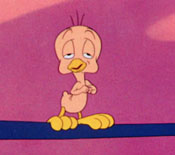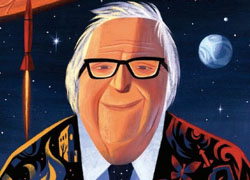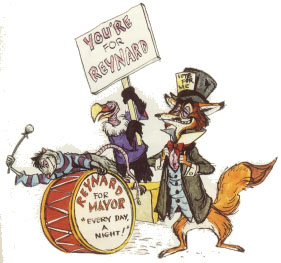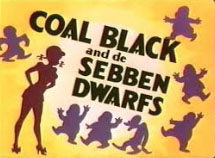 Pre-Tweety. Before the creation of Tweety Bird in 1942, Bob Clampett had done sketches of two newly hatched baby birds who were to be named “Twick’n’Tweet”. In existence is a copy of a letter Bob wrote to a friend in the Harry Lewis Orchestra from 1936. It is on MGM letterhead paper and near the image of MGM Leo the Lion, Bob drew a caricature of a naked baby bird saying, “I Tink I Tee A Titty-Tat”. At the time, Clampett was developing an animated John Carter of Mars project that MGM was considering releasing.
Pre-Tweety. Before the creation of Tweety Bird in 1942, Bob Clampett had done sketches of two newly hatched baby birds who were to be named “Twick’n’Tweet”. In existence is a copy of a letter Bob wrote to a friend in the Harry Lewis Orchestra from 1936. It is on MGM letterhead paper and near the image of MGM Leo the Lion, Bob drew a caricature of a naked baby bird saying, “I Tink I Tee A Titty-Tat”. At the time, Clampett was developing an animated John Carter of Mars project that MGM was considering releasing.
As for Tweety appearing naked in his first cartoon: “I had this scene where the character said, ‘here comes the naked genius now’,” recalled Clampett in my interview with him in 1978. “It was the name of a popular book at the time and it was just supposed to be a gag reference but some people took it literally so the word came down that the bird should be covered.”
Winsor Wisdom. Cartoonist and animation legend Winsor McCay was quoted in “Cartoon and Movie Magazine” magazine of April 1927: “The part of my life of which I am proudest is the fact that I was one of the first men in the world to make animated cartoons. I went into the business and spent thousands of dollars developing this new art. It required considerable time, patience and careful thought—timing and drawing the pictures. This is the most fascinating work I have ever done—the business of making cartoons live on the screen.”
 Ray Bradbury Animation Memories. In 1980, author Ray Bradbury wrote for the “The Moving Image” catalog about an interesting memory: “About three years ago the Disney people asked me to write a one-hour television documentary on old Uncle Walt’s life. Part of my pay was being able to sit in a dark projection room for two weeks, running some 200 or more shorts and features.
Ray Bradbury Animation Memories. In 1980, author Ray Bradbury wrote for the “The Moving Image” catalog about an interesting memory: “About three years ago the Disney people asked me to write a one-hour television documentary on old Uncle Walt’s life. Part of my pay was being able to sit in a dark projection room for two weeks, running some 200 or more shorts and features.
“When the lights came up, I was stunned. For I realized I had seen them all before, every one, and remembered them all, from the age of eight right on up through my teens. That’s how important animation has been to me. My mind is crammed full of images from that vast and magical past where clowns and cats and mice popped out of ink bottles and ran across my eyeballs to lodge in my retina and hide in my brain.
“They are still in there, capering and rushing, destroying and being destroyed. To this day, my love for the whole blasted wonderful field remains unabated.”
Flashing Forward. Animation legend Dick Huemer got into animation by going up to the door of the Raoul Barre studio in 1916 and asking for a job. For three weeks, he spent time doing what Huemer called “tracing” when he was promoted into animating. One of Huemer’s observations was that when something was moving very fast on screen that all the audience saw was a blur, not the actual object.
“So, I decided that I would save all that work of inbetweening by just having a bunch of lines or smudges, just scrabble, from position to position, when something moved fast,” recalled Huemer. “To prove it, I had an alarm clock flying through the air and right in the middle of the action, I put a brick.
“And when they ran the finished film, you didn’t see the brick! It proved that you really didn’t see what was in the middle. But I overdid it. Finally it looked like haystacks in between from position to position to position, and then Barre told me to knock it off. He was always polite. He said softly, ‘Let’s make the inbetween like everyone else, eh?’”
 Disney’s Reynard. Two months after the release of “Snow White”, Walt Disney was looking at a treatment for an animated feature about the legend of Reynard the Fox by Dorothy Ann Blank and Al Perkins. “I see some swell possibilities in Reynard,” said Walt in a story meeting. “Our main character is a crook and there’s nothing about him having a ‘Robin Hood’ angle. That’s what I am afraid of. Maybe there is an angle that we’ve always accused the fox and maybe we could prove that he is really not that type. Started out all right, and then we show how he goes wrong, really innocent, but the law has always been after him and he’s had to use his wits.”
Disney’s Reynard. Two months after the release of “Snow White”, Walt Disney was looking at a treatment for an animated feature about the legend of Reynard the Fox by Dorothy Ann Blank and Al Perkins. “I see some swell possibilities in Reynard,” said Walt in a story meeting. “Our main character is a crook and there’s nothing about him having a ‘Robin Hood’ angle. That’s what I am afraid of. Maybe there is an angle that we’ve always accused the fox and maybe we could prove that he is really not that type. Started out all right, and then we show how he goes wrong, really innocent, but the law has always been after him and he’s had to use his wits.”
Walt was actually more excited about the possible settings for the action. “I’d like to see some scenes in a dive underground…and the way he has to get into things…back passages like the sewers of Paris.” Another treatment was presented in 1945 and no less than three different treatments in 1947. At one point, it was seriously discussed to have the pirate Long John Silver tell the tales (in animation) to Jim Hawkins in the live action film “Treasure Island” to gain the boy’s trust just like Uncle Remus told three animated tales in “Song of the South”. Many of the ideas for the various treatments of the Reynard story ended up in the Disney animated feature “Robin Hood” (1973).
Bugs’ Vegetables. While researching his book, “Bugs Bunny: Fifty Years and Only One Grey Hare”, animation historian Joe Adamson discovered that at one time the Utah Celery Company of Salt Lake City offered to keep all Warner studio staffers well supplied with their product if Bugs would only switch from carrots to celery. Later, the Broccoli Institute of American strongly urged that Bugs sample their product once in a while. Isn’t it about time that all of Adamson’s wonderful interviews with people in the animation industry be compiled in a book or series of books? I still remember how groundbreaking it was when Adamson’s book “Tex Avery: King of Cartoons” came out in 1975. That first edition rests proudly on my animation book shelves.
 The Black Panthers and Coal Black. In 1979, historian Reg Hartt shared the following story he had heard from animation legend Bob Clampett. Bob did a presentation of his animation in Los Angeles as he often did. However, this time he was going to include a showing of Coal Black An’ De Sebben Dwarfs (1943). The Black Panthers militant group objected strongly and there was fear about possible violent action. The film was not included in the screening.
The Black Panthers and Coal Black. In 1979, historian Reg Hartt shared the following story he had heard from animation legend Bob Clampett. Bob did a presentation of his animation in Los Angeles as he often did. However, this time he was going to include a showing of Coal Black An’ De Sebben Dwarfs (1943). The Black Panthers militant group objected strongly and there was fear about possible violent action. The film was not included in the screening.
Apparently, one of the concerns was that at one point, the supposed hero had a yellow streak down his back.
Later that same day, that group met with Los Angeles Mayor Tom Bradley (who was African American). He asked them what they had been doing earlier and they mentioned they had been at a screening of Bob Clampett cartoons. Bradley brightened up and told them that Clampett was responsible for his favorite cartoon of all time that he had only seen once while in France during World War II: “Coal Black An’ De Sebben Dwarves”.


 Jim Korkis is an internationally respected animation historian who in recent years has devoted his attention to the many worlds of Disney. He was a columnist for a variety of animation magazines. With his former writing partner, John Cawley, he authored several animation related books including The Encyclopedia of Cartoon Superstars, How to Create Animation, Cartoon Confidential and Get Animated’s Animation Art Buyer’s Guide. He taught animation classes at the Disney Institute in Florida as well as instructing classes on acting and animation history for Disney Feature Animation: Florida.
Jim Korkis is an internationally respected animation historian who in recent years has devoted his attention to the many worlds of Disney. He was a columnist for a variety of animation magazines. With his former writing partner, John Cawley, he authored several animation related books including The Encyclopedia of Cartoon Superstars, How to Create Animation, Cartoon Confidential and Get Animated’s Animation Art Buyer’s Guide. He taught animation classes at the Disney Institute in Florida as well as instructing classes on acting and animation history for Disney Feature Animation: Florida.




















































Oh how I adore your Fridays. It was worth it, alone, to find out that “Naked Genius” was a popular book.
I’m pretty sure that Naked Genius came out in 1933. Also seeing as how it was a collection of poetry written by North Carolina slave George Moses Horton’s in 1865 I’m not sure how popular it would be in 1942.
As a matter of interest in 1941 “Naked Genius” was an alias for Gypsy Rose Lee as seen in the 6 October 1941 issue of LIFE magazine:
http://books.google.com/books?id=xE4EAAAAMBAJ&lpg=PA110&dq=%22Naked%20Genius%22&pg=PA110#v=onepage&q=%22Naked%20Genius%22&f=false
In any case, the book is currently available http://www.amazon.com/Naked-Genius-George-Moses-Horton/dp/B0006E9NOO
…though the “naked genius” line didn’ts show up until Tweety’s third cartoon, voiced by the Jimmy Durante cat in “:A Gruesome Twosome”.
That’s right. A Gruesome Twosome came out in 1945. Gypsy Rose Lee’s 1943 Broadway Show “The Naked Genius” was more likely the source for that line rather than a 1933 book of poetry.
http://www.ibdb.com/production.php?id=1346
Reminded myself of some drawings from the Reynard project done by Bill Peet I loved seeing.
http://www.pinterest.com/pin/30891947417390824/
http://www.pinterest.com/pin/30891947417390902/
http://www.pinterest.com/pin/30891947417390892/
http://www.pinterest.com/pin/30891947417390857/
I wish I could make a cosmic bargain with God to get back all ten hours of Erich von Stroheim’s masterpiece “Greed” in exchange for wiping “Coal Black and de Sebben Dwarves” from the face of the planet. And I sincerely doubt the veracity of that Tom Bradley story, although I’m sure Clampett told it as often as he needed to.
Now why would you do a dumb thing like that? I rather have that short on DVD anyway (along with other on a TCM exclusive disc).
John: Make the deal with satan.
Watch this video with the audio off and decide if the images within are any less degrading than those seen in Coal Black.
https://www.youtube.com/watch?v=hiP14ED28CA
There are plenty more like it out and Bob Clampett is nowhere around.
Clowns like Snoop and the garbage they produce give people like you all the justification in the world to champion racist crap like “Coal Black.” Consequently, while I’m bargaining to get back the full version of Von Stroheim’s “Greed”, I’d also like most of the lost silent films of W.C. Fields back in exchange for the annihilation of Snoop Dogg. And I’ll gladly request if from whatever deity can deliver the goods. Nothing “dumb” about that.
Racist or not, I wouldn’t mind that cartoon to be in the National Film Registry. I might be going too far there, (I doubt Warners would stand for that).
Nothing “dumb” about that.”
Except believing that will actually ever happen. There’s a better chance of success by looking for those films yourself, then breaking in WB’s vaults and destroying their negative of Coal Black. (or visa versa depending on your priorities) than by turning to the supernatural.
I only say this because, as of yet there is no recorded case of of films being found (or materialized out of thin air) through a ‘higher’ power. Not even from those psychics on TV. Sad but true. Sure, some films are said to be lost through “acts of God” but usually not resulting in anything in return except noxious nitrate fumes.
Also, when dealing with Satan, he’d probably also want your immortal soul in exchange for any bargain. Or so I’m told.
And this is my final word on “Coal Black” and films of its kind, as eloquently expressed by Harry Belafonte:
https://www.youtube.com/watch?v=Yfj6Ja86lCs
Birth of a Nation in the Wilson White House? Ancient history. I know, let’s trade the 1970’s film Superfly. The image of Black audiences cheering as the drug dealing hero beats up the always corrupt always White police officers to save the day. Yup, let’s destroy that one too in exchange for a Lost Film. As if that was possible.
Harry Belafonte as a Moral Compass and a Voice of Reason? Wow.
I prefer the eloquence of Ray Bradbury in Fahrenheit 451. I think he summed up your position quite well in the character of Beatty the Fire Chief:
“Now let’s take up the minorities in our civilization, shall we? Bigger the population, the more minorities. Don’t step on the toes of the dog-lovers, the cat-lovers, doctors, lawyers, merchants, chiefs, Mormons, Baptists, Unitarians, second-generation Chinese, Swedes, Italians, Germans, Texans, Brooklynites, Irishmen, people from Oregon or Mexico. All the minor minor minorities with their navels to be kept clean. Authors, full of evil thoughts, lock up your typewriters. They did.
Not everyone born free and equal, as the Constitution says, but everyone made equal. Each man the image of every other; then all are happy, for there are no mountains to make them cower, to judge themselves against. So! A book is a loaded gun in the house next door. Burn it. Take the shot from the weapon. Breach man’s mind. Who knows who might be the target of the well-read man? Me? I won’t stomach them for a minute.
You must understand that our civilization is so vast that we can’t have our minorities upset and stirred. Coloured people don’t like Little Black Sambo. Burn it. White people don’t feel good about Uncle Tom’s Cabin. Burn it. Someone’s written a book on tobacco and cancer of the lungs? The cigarette people are weeping? Bum the book. Serenity, Montag.”
I realized that I failed to state why Harry Belafonte, Jr is just an example of how not to behave.
His work to advance civil rights in the Sixties was admirable, but he’s obviously long ago reached that point in his life where he stopped ripening and began to rot.
http://archive.frontpagemag.com/readArticle.aspx?ARTID=21534
No fool like an Old Fellow Traveler Useful Idiot Fool.
who voice the characters in ” Coal Black an de sebben dwarfs.”?
Vivian Dandridge did the voice of So White. Ruby Dandridge was the wicked queen. Leo Watson was Prince Chawmin’ and a couple of the dwarves, while Mel Blanc was the smallest dwarf and all of the incidental voices.
The controversy that continues to encircle “Coal Black” only upholds its title as the GREATEST CARTOON OF ALL TIME.
NO IT AIN’T